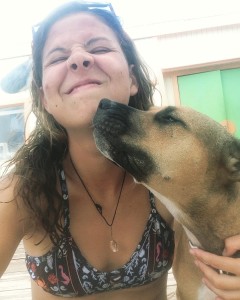My original plan while staying with Jeff in Fort Lauderdale was to dive every day until September 1st, which was my no-fly day before heading over to spend 5 days at the Bimini Biological Field Station (also known as the Shark Lab). But we all know how rarely things usually go according to your plan. Over the past few days a tropical storm had been brewing in the Caribbean and looked as if it were heading straight towards south Florida. Playing it safe, Jupiter Dive Center decided to cancel the dives scheduled on Sunday and Monday, in case things took a turn for the worse. So instead of spending Sunday diving, I spent it sleeping in! I had a chance to catch up on sleep as well as emails and laundry, which I took full advantage of. After spending the morning completing those chores, Jeff asked if I wanted to go on a land adventure for the afternoon, as it looked now that the tropical storm was breaking up before hitting Florida. Of course I wanted to explore some of the land attractions, so we jumped in the car and headed to the Loxahatchee State Park, which showcased the diverse ecology of south Florida. It was a spacious park with marsh, wetland, and cypress groves and because of the overcast weather; it was relatively deserted for the day.
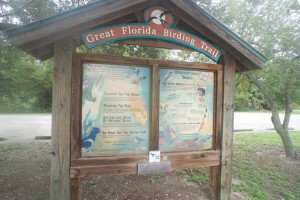
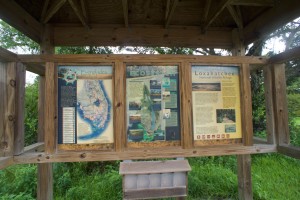
We walked around the marsh, stopping to watch a butterfly or bird through our binoculars (Jeff not only knows all his marine species, he is an expert terrestrial naturalist as well and could identify most birds, butterflies, and plants around us!) After walking around for a while, the skies opened up on us and the rain drove us to seek shelter in the nearby visitor’s center, which had some nice exhibits on the ecology and wildlife of the park. The rain did not seem to want to relent, so as we were headed to another nearby park (in hopes of nicer weather) we got a call from Missy, who told us that Jim Abernethy was on his way to the park with a few of the guests Jeff had arranged on a liveaboard trip to Tiger Beach. We managed to meet up with them at the visitor’s center, and I got the chance to listen to some of Jim’s incredible stories as well as see some great photos from the trip they just took to dive with tiger sharks. At the end of our get-together, Jim invited Jeff and me to go diving with his company the very next day. It couldn’t have been more perfect – Jupiter Dive Center had canceled our dive for Monday, but now we had another boat to go on! Looks as if I wouldn’t be missing out on quite as many dive days. We parted ways with Jim and headed back to Fort Lauderdale, as we had dinner plans for that evening and needed a little time to clean up. I was stoked about my chance encounter with Jim, a renowned shark diver and conservationist, and was honored to be invited out for a day of diving. Its incredible how well things end up working out in time!
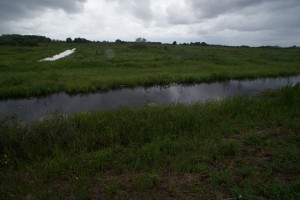
Monday came bright and early, with gorgeous weather (despite the predictions earlier in the week for huge rain showers). Jeff and I loaded up the car and made our way to West Palm Beach, where Jim’s shop is located. After meeting with Jim, signing paperwork, and finalizing plans for the day, Jeff and I headed to a nearby diner for a nice breakfast. By 10 am we were at the dock, loading up our gear, and getting ready to go out for a nice day of underwater adventures. To make things even better, the dive boat (which would normally hold over 20 guests) only had 12 of us for the day! This meant more room to stretch out and be comfortable, both above and below water. Our captain took us out to the first dive site of the day, a site called Corridor, which was a series of wrecks strung out along the seafloor. The first wreck in the chain was a known location for goliath grouper aggregations, so we planned to spend about 20 minutes on the wreck with the groupers, then let the current carry us to the rest of the wrecks. After the briefing we geared up and got ready to jump in. With so few divers, we quickly descended to the wreck where the groupers hovered around the chunks of rusted metal. It was a healthy current but we spent a good amount of time at the first wreck shooting photos of the fish before letting ourselves go with the flow to the rest of the wrecks.
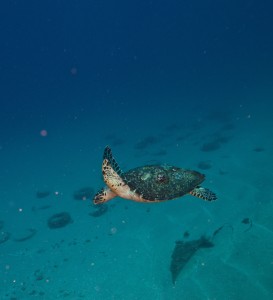

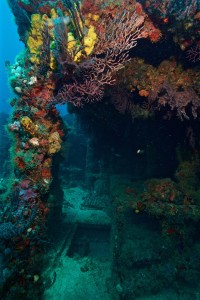
It was a fast paced dive but loads of fun as we drifted and kicked about, stopping every now and again to check out a turtle or fish before letting the current carry us away again. After about an hour we slowly ascended and finished our dive. Back on the boat, we had a nice surface interval and loads of snacks before gearing up and getting ready for our second dive. The next site was called Toy Box, which was a site composed of a wreck then a series of large concrete pipes and structures jumbled along the seafloor, reminiscent of giant children’s toys scattered about. We hopped in and got to finning, spending the first 25 minutes at the wreck then allowing the current to push us across the concrete forms on the seafloor. The huge structures served as elaborate and intricate habitat for a variety of sealife, so I had plenty of fish and interesting creatures to attempt to photograph during my dive!
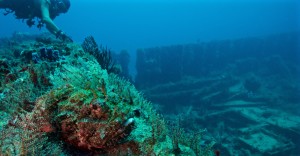

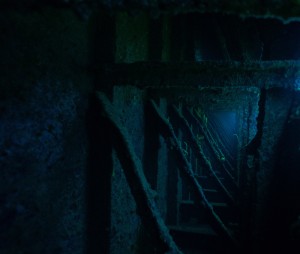
After another solid hour of diving, we surfaced, got picked up by the boat, and made our way back to the dock. It was another gorgeous day of diving in south Florida! Back at the dock we met with Jim, said our thanks for his generosity, and headed back to Fort Lauderdale. We had another evening out for dinner, and I was looking forward to another night of amazing food and even better company with Jeff and Missy. They were going above and beyond to give me the best stay possible in Fort Lauderdale, and I couldn’t be more grateful.
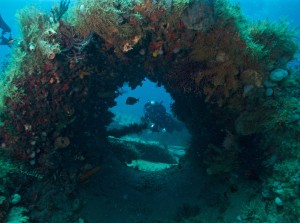
Tuesday was my no-fly day, so despite the gorgeous weather, I couldn’t go diving. Instead, we took the morning to visit the Nova Southeastern Oceanographic Institute, a new research center where groundbreaking work was being done to further our understanding of the marine world. Jeff knew a few of the researchers and one of the Master’s students offered to give us a tour of her lab, where she was doing work on the genetics of oceanic white tips, to determine if there was one large global population or a series of subpopulations based on location. It was a treat to visit the lab, which was well funded and well equipped to support a variety of research projects. After the tour, we headed back to allow me a bit of time to pack and rearrange gear for my upcoming trip to Bimini. Once my small bag was packed for Bimini, we loaded the car up and drove down to Miami, where we would meet up with Doc and Marie Gruber, founders of the field station. We met at their home then headed to a nearby Mexican restaurant for a delicious dinner and lots of stories from Doc, who is a world-renowned shark biologist. I had been graciously invited by Doc and Marie to spend the night at their home, as the small airport I’d be departing from the next morning is 15 minutes from their home, and one of their coordinators was bringing supplies from their home to the flight, so I could catch a ride in the morning. It was a honor to spend the evening with the Grubers, and I admit I was a bit dumbstruck to be in such company for the evening.
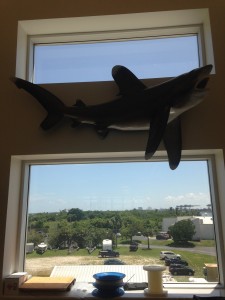
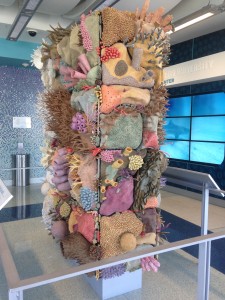
Wednesday I was up nice and early to meet with the coordinator who was bringing food supplies for the lab from the Gruber’s home to the airport. After loading the truck with food and my luggage, we made the short drive to the airport where the small charter flight was departing from. At the airport I met up with the 3 other guests participating in the “Research Experience” – it was a nice mix of people and I knew we would have a fun week ahead of us. The pilot met with us, filling out some paperwork and verifying our passports before we headed out to the small 8-seater plane that would hop us over to Bimini (a 45 minute flight).
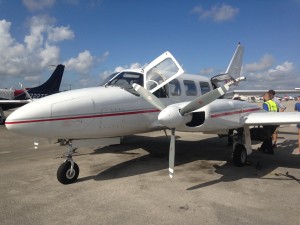
Upon landing in Bimini, we passed through customs and were met by a few staff from the lab, who helped us load our gear plus the food into the truck and before we knew it, we were on our way to the lab. The food was offloaded, we were given a brief introduction to the lab, and then we were driven to the nearby accommodation where we would be spending the next 4 nights. Due to limited space at the lab (which is where the staff/volunteers live), research experience guests are set up at a condo that is a five-minute walk from the lab. We were given an hour or so to settle into our condo before we headed back to the lab to be given a proper tour and introduction to the facilities and the staff. We were given a thorough briefing about life at the lab then we sat down with the staff and volunteers for lunch (everyone eats together for meals, which is a nice touch!) After lunch, we were given a project lecture by one of the PhD students currently working at the lab before we headed out for our first activity on the water – the shark snorkel!
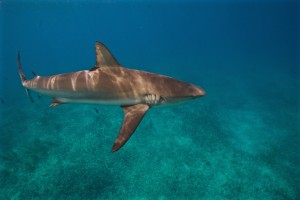
We drove out by boat to a spot known as the Triangle, where we moored up the boat and set out a float line. The staff gave us an in-depth briefing about what was going to happen during the snorkel, and we were all excited to get in the water and see some sharks. Once everyone was ready to go, we slipped in the water and grabbed onto the float line, shoulder to shoulder. One staff member stayed onboard to throw out chunks of fish for the sharks to eat right in front of us! About 4 or 5 Caribbean Reef Sharks showed up to feed, and we got some nice, close encounters with these gorgeous sharks.
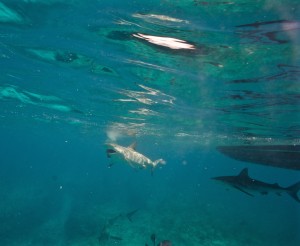
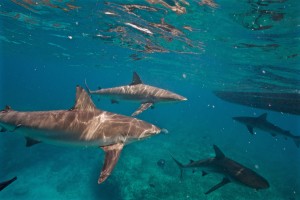
Once the fish was gone, we were allowed to release the line and snorkel about the site, diving down to look at fish and coral while a few of the sharks hung around. Once we had our fill, we hopped back on the boat and made our way back to the lab. We put away our snorkel gear and met with Mo, another PhD student who was taking us to do a short shark biology and handling course. We waded out to the shallow shark pens that were built in the sand flats around the back side of the lab.
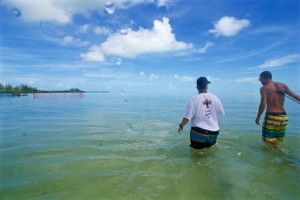
Mo opened the pen and we all clambered in, excited to do some hands-on learning! After searching the murky water for 10 minutes, we sadly realized the juvenile nurse sharks had escaped during the abnormally high tides of the past few days (where the tide waters were so high they completely submerged the 8-foot high pen). The two resident stingrays had stuck around, so we spent some time feeding them by hand and talking about stingray biology instead. Once the rays were full, we headed back for the group dinner at the lab.
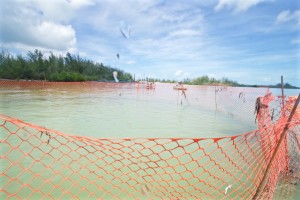
Dinner marks the end of our scheduled day with the field station, so we headed back to the condo to clean up. While the other two ladies were showering, I decided to do a bit of exploration and wandered to a nearby beach, where I walked for the remainder of the sunlight, scouring the sand for shells and bits of coral. As light slowly faded, I made my way back to the condo where I took a quick shower and fell asleep by 9:15 pm!
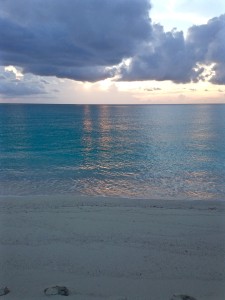
Thursday I woke up quite early, thanks to my early bedtime the night before and I decided to return to the beach for a morning walk before heading over to the lab for breakfast. After breakfast, we were told the plan for the day – we’d start by spending the morning watching volunteers capture and work up juvenile nurse sharks, then after lunch and a lecture, we’d set out 3 longlines in hopes of catching some adult sharks to work up for on-going studies. We grabbed our snorkel gear, loaded up in boats, and headed out to the area the sharks would be caught in. While the two catching boats started their search for young sharks, our boat went to a nice snorkel spot and spent 45 minutes snorkeling over a seagrass bed, where I spotted a few nurse sharks and a small southern stingray.
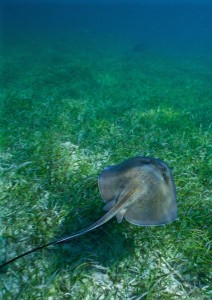
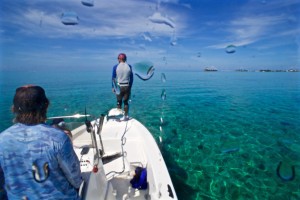
We were radioed once the volunteers had grabbed a few sharks and transported them to the boat doing the work ups. We tied up alongside to the work up boat, watching as they measured and weighed sharks as well as inserted small tags into the young sharks so they could be continuously monitored for data collection.

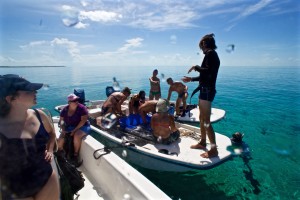

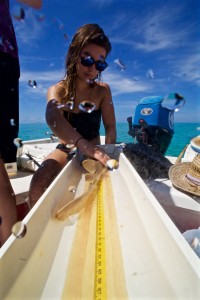
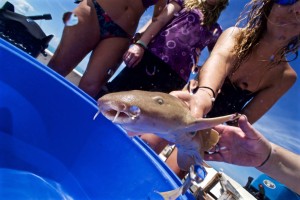
After a shark was worked up and tagged, a volunteer would firmly grasp the shark and swim it down to a ledge, where it could seek refuge and recover from its small ordeal. After watching a few work ups, we got invited to watch some of the volunteers catch a shark, which is quite the process. First, you freedive down to a small ledge about 10-12 feet deep, looking underneath for the small sharks which seek the shelter of the ledge for protection. If a shark is spotted, you surface, take a nice deep breath, then dive back down, stick your arm under the ledge, firmly grasping the shark by it’s first dorsal fin, often spending near a minute attempting to bring the wriggling shark up from under the ledge.
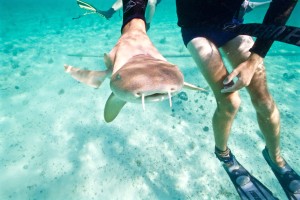
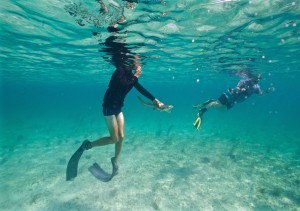
Its quite the sight to see and the volunteers often come up with the shark as well as scraped hands and bloody knuckles from the struggle. We spent the whole morning watching sharks get collected, worked up, then released, before heading back to the base for lunch and a lecture by Christian, the director of the lab. He gave us a wonderful talk about how the lab got started and some of the long-term research on lemon sharks being conducted at the lab. At the end of his lecture, we headed out to the boat, which was being loaded by two of the staff with all the gear to set out 3 longlines. The lab periodically sets out shallow longlines along the sand flats to capture adult sharks (primarily tigersharks, hammerheads, and lemon sharks). These sharks are worked up as well and usually will then have an acoustic tagger inserted into their body cavity to provide patterns of movements of individuals of various species.
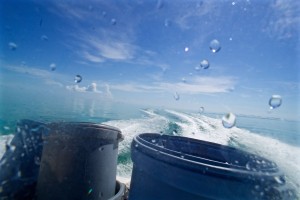
Setting a longline is not necessarily a difficult task, it just takes a bit of practice to be efficient at it. While one staff member drove the boat, one fed out the 500 meter long line, which is marked at 25 meter intervals with either orange or green spray paint. At the orange spray paint a small float is clipped to the line, at the green paint, a baited hook (called gangion) is clipped.

The first line we set out went slowly, awkwardly and more than a bit tediously, but it was our first time, so not much was to be expected. Once one line was set in place, we motored over to the GPS coordinates where the second line was to be placed. Again, we set to clipping floats and hooks as we slowly spooled out the line, definitely working a bit more quickly, but still with our fair shares of mistakes and hold ups. The third line we set out the most efficiently, definitely having a better feeling for the flow of the set, managing to get the components in place in much better time. Once all three lines had been set and anchored, we quickly drove past to make sure there were no tangles or problems, than hopped in the water for a quick swim to cool off. We couldn’t have asked for better weather that afternoon, the seas were as flat as glass and the sun shone brightly in the clear blue sky.
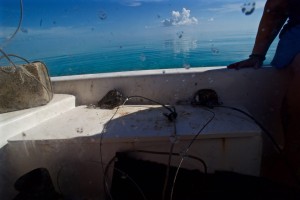
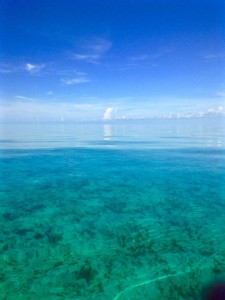
After everyone climbed back onboard, we headed back to the lab for dinner with the rest of the crew. After a delicious dinner, we set back out on the water to do the first check of the longlines. Once set, the lines need to be checked about every 4 hours, for if a shark has been hooked, you don’t want it hanging off the line for too long. We cruised out in the fading sunlight, using a bright spotlight to guide the way to the first line. About half way down the line we found an adult nurse shark that had been hooked, so we pulled it up alongside the boat to do a quick work up – we measured it, got some fin clips for DNA samples, checked for previous tags, and placed a new tag. Once all the work was done, we cautiously removed the hook and set the shark free. We then zipped over to the second line, where our check revealed an adult lemon shark that had been hooked. Lemon sharks are a lot more feisty that the nurse sharks, so greater care had to be taken. The staff took the length measurements, sex, fin clips, and checked for tags, which it already had on–a VEMCO tag. Due to its large size, they also decided to perform a quick surgery to insert an acoustic tagger to gather a wider range of data from the shark. One of the staff got to work cutting a slit on the ventral side of the shark, close to the anal fins. Once the cut was large enough and through to the body cavity, they inserted the tagger, then quickly sutured up the incision. The shark was then freed from the hook and set free back in the water. We checked the rest of the line, which was empty, then headed to the third line to complete the check. The last line was empty, so we tidied up the boat and headed back for the lab. For the rest of the night, groups of staff and volunteers would head out every 4 hours to check the lines, working up any sharks that had been caught.
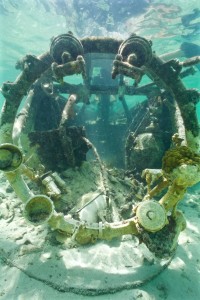
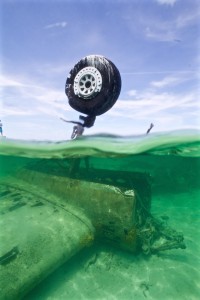
The lab had a tour scheduled for Friday morning by two vacationers, so the research experience guests were invited to join in with the guests. One of the volunteers was leading the tour and after a quick walk around the property, we headed over to the shark pens to learn about basic shark biology. This time there were a few juvenile nurse and lemon sharks, so a small nurse shark was used as our teaching prop. We went over basic functions of the species as well as features that distinguish it from other species.
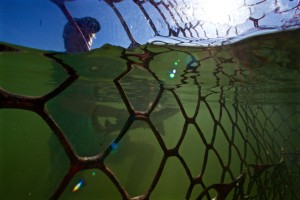
The tour also involved a discussion of the long-term research being done at the lab plus current issues threatening shark populations. By 10:30 or so the tour had concluded and we then loaded up on boats to head out to the shallow flats to attempt to capture a large stingray. Mo, one of the PhD students, needed to tag several large stingrays for his project, which was our task for the rest of the morning. We slowly cruised over the shallow seagrass beds alongside the mangroves, scanning the water for dark circular patches that usually indicated a stingray.
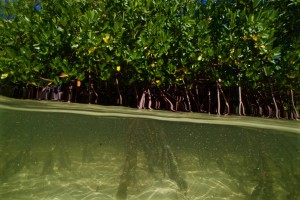
After 20 minutes of searching, we found a large female and everyone hopped off their boats into the waist high water. Using nets and poles, we attempted to circle the ray, but large gaps between people allowed the ray to skirt past us and make its escape. Not to be discouraged, we all hopped back on boats and after a brief discussion on how to do better the next time, we set out to find another ray. 10 minutes later, another large stingray was found and this time, we slipped cautiously into the water, taking much more care to surround the ray and keep it in the circle we formed with our bodies. As we tightened our circle, the ray lost its chance to escape, and we scooped it up in a large net and placed it in a tub on the boat. It was then brought back to the lab for a work up and to confirm it was large enough for the acoustic tag. The other two boats kept cruising the shallows, scanning for another ray in case the first wasn’t large enough. After 15 minutes, we got the radio signal that the ray was a good size and they were going to work it up and insert the tag.
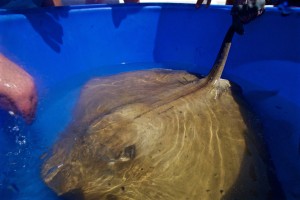
We motored back to the lab to meet up with the crew and watched as they took fin clippings for DNA then made the long, shallow incision into the body cavity to insert the tag. The ray was then stitched back up and taken back out to the seagrass beds to be released. After a quick lunch, the research experience group was given a choice to either do a land tour of North Bimini or go out to look for dolphins. We all unanimously decided to go out looking for dolphins, as it was a gorgeous day and a water activity was preferred over any land tour. We loaded up the boat with our snorkel gear and cameras, then headed out to the sand flats past North Bimini, where the dolphins are normally found. We cruised and cruised, scanning the horizon for signs of a pod – usually indicated by a series of small dorsal fins breaking the surface. After an hour or so of looking in all directions, we all had started to think that maybe it wasn’t in our luck for the day. We started to head in the general direction back towards South Bimini but barely moments later, a small dorsal fin was spotted breaking the surface! Sure enough, we had found a small pod of bottlenose dolphins and we quickly donned our snorkel gear in anticipation of jumping in. The boat pulled up close to the pod and when everyone was ready, we splashed in the water. it was a small group of about 5 dolphins, but there was a mother and her calf, and the calf was incredibly curious and playful.

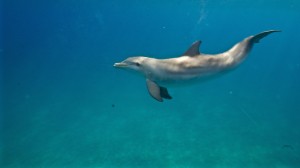
It would swim right up to us at the surface, gazing right into our eyes, spinning about, flicking its little tail, and making playful clicking sounds (all under the careful eye of the mother, who was never too far away) . the experience was absolutely amazing – these wild creatures were engaging with and interested in us, swimming mere feet away and playfully moving through the water around us. After 10 minutes or so, the pod gathered and swam off, much faster than we could keep pace with. We jumped in the boat and motored over to the pod and within moments were back in the water, for another 30 minutes or so, swimming and freediving with these graceful creatures. It was usually just the mom and calf hanging around us, the other 3 dolphins were much more distant, always hanging just within view, but not really engaging with us.
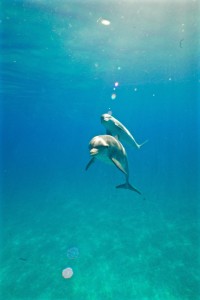
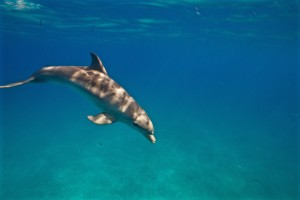
After a while, the other 3 dolphins came in close and one of the males made it obvious that play time was over, so we hopped back in the boat and let the pod continue with their day. We were all beaming from ear to ear, completely euphoric about the encounter we just had. It was the perfect afternoon and we cruised back to the shark lab for dinner (which included freshly caught and fried conch, a local Bahamian delicacy I had yet to try).
Saturday was our last full day at the shark lab, and once again, it was jammed pack with activities. After the usual breakfast, we loaded into a boat and headed to a mangrove stretch along North Bimini, which is a known nursery for lemon sharks. We started out with a nice drift snorkel along the mangroves, looking at the variety of fish and marine creatures that resided among the red roots of the mangroves. This was also a learning moment – mangroves are critical nursery habitat, not just for sharks, but for all sorts of marine flora and fauna.
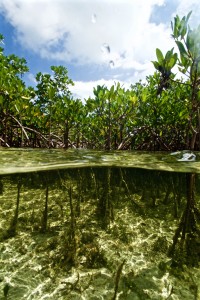

Yet in many island nations such as the Bahamas, the mangroves are the first habitats to get destroyed when new buildings and developments are made (usually for tourism). After our nice long snorkel along these beautiful trees, we pulled into a nearby beach for a small lunch of sandwiches, pasta salad, and brownies.
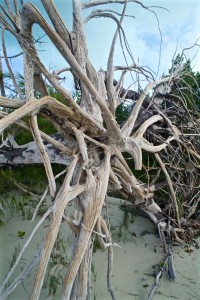
We waited for a nearby storm to pass by overhead, then got back in the boats and headed to a nearby place in the mangroves known as “Aya’s spot.” This is a small back pond in the mangroves that is only accessible around high tide, by wading through a narrow, natural channel through the mangrove roots.
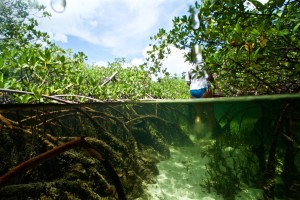
Juvenile lemon sharks use this area as protection, swimming in on the incoming tide and spending a few hours in the protection of the shallow pond, where larger sharks can’t get in due to their size. We slowly waded to the pond, where 7 or 8 juvenile lemon sharks were seeking refuge. After a forming a line, blocking the entrance/exit tunnel, we each grabbed a frozen squid and held it just below the surface of the water. We waited a few moments, letting the squid’s scent float to the sharks a few meters away. Finally, one shark gathered enough courage to swim up to us and snatch the squid out of our hands.

Once that first shark made its move, the rest gathered their courage and joined in, feasting on the little squids we handed out to them.

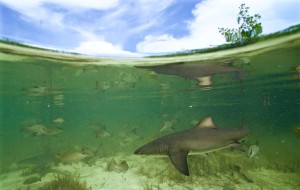
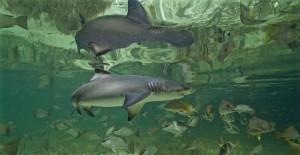
It was an amazing experience to hand feed these little sharks, getting so close to them yet not worrying at all about being bitten or attacked. After all the squid were handed out, we slowly made our way back out of the channel and to the boat.
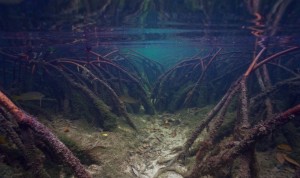
Our last activity for the afternoon was to join with a boat of staff attempting to capture and tag black tip sharks. Black tips are well-known as being skittish and difficult to catch, and unfortunately, they were having no luck all day long. Regardless, we headed over to see what methods were being used to try to capture these beautiful sharks and we spent some time snorkeling over the sand flats. Fish was being descaled and chopped up to use in bait boxes to lure sharks in. Almost out of nowhere, a large rain passed overhead and we waited in the downpour for the weather to pass before we decided to call it a day and head back to the lab.
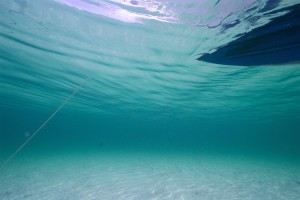
I couldn’t believe how quickly my time at the shark lab was winding down to a finish, but what a week I had had! There was such an incredible array of experiences and I was so grateful for all that I learned during the five days at the lab. It was truly a worthwhile experience and I am always encouraged by places like the shark lab that are working to advance our knowledge of the marine world, not for monetary gain, but because of passion and curiosity. And just like that, another week had flown by and I was again getting ready to move on to the next adventure.
